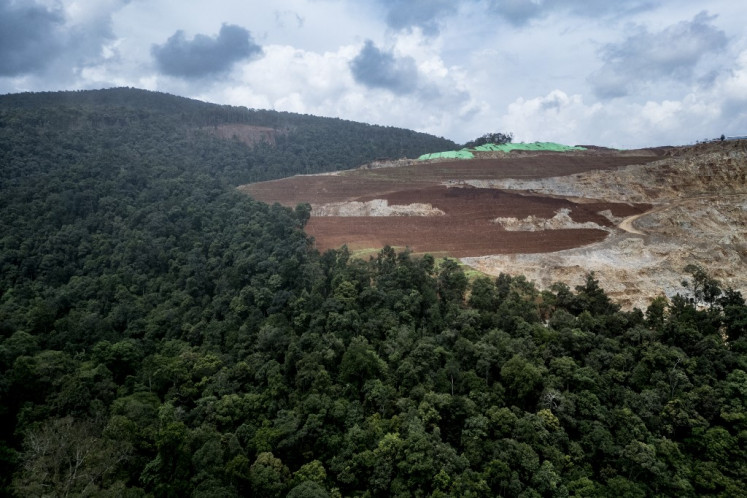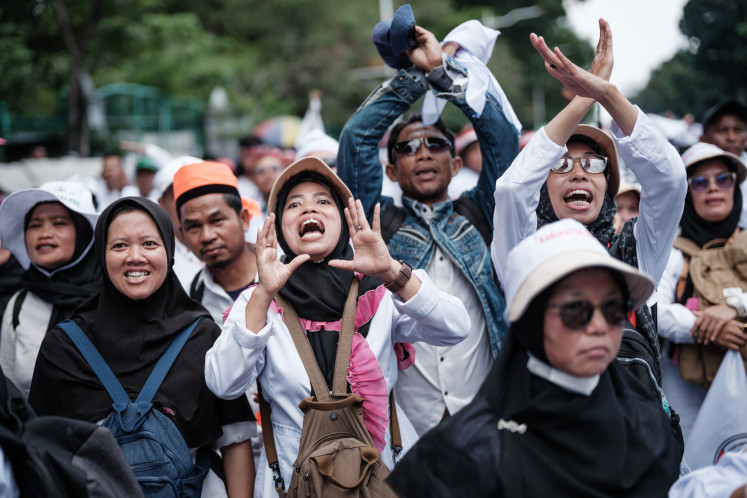Popular Reads
Top Results
Can't find what you're looking for?
View all search resultsPopular Reads
Top Results
Can't find what you're looking for?
View all search resultsRI signs bilateral funding agreements
While the pledges for huge amounts made at multilateral talks remain to be seen, Indonesia has signed a number of bilateral agreements with richer nations to get climate funding — mostly in forest-related areas
Change text size
Gift Premium Articles
to Anyone
W
hile the pledges for huge amounts made at multilateral talks remain to be seen, Indonesia has signed a number of bilateral agreements with richer nations to get climate funding — mostly in forest-related areas.
State Environment Minister Gusti Muhammad Hatta argued that the bilateral deals were currently the faster way to get climate funding.
“But, even without their money Indonesia will go ahead to protect the planet,” Hatta told The Jakarta Post on Wednesday.
“It is our moral responsibility to tackle climate change for the sake of our people.”
He also insisted that bilateral agreements would not ruin ongoing multilateral talks on climate change after the Copenhagen conference failed to hammer out a binding agreement on emissions cuts and climate funding.
After the Copenhagen meeting Indonesia signed MoUs on climate change issues with the governments of Australia, England, Germany, the Netherlands, Japan, Norway, New Zealand and the United States.
The Australian government has provided A$30 million (US$27.74 million) to fund a Reducing Emissions from Deforestation and Forest Degradation (REDD) project in Jambi, which is scheduled to begin in January.
Jambi’s forests are estimated to cover around 2.1 million hectares.
It also channeled A$40 million to another REDD project in Central Kalimantan in 2009.
It is not clear how much funding has been promised from other countries but most of the money will be used to cut emissions from the forestry sector.
Indonesia is the world’s third-largest forest nation, with around 120 million hectares of rainforest.
However, it has also been labeled the worlds fastest in deforestation, with more than 1 million hectares of forests cleared each year.
A study by the Bogor-based Center for International Forestry Research (CIFOR) warns that billions of dollars set to flood into Indonesia was at risk because of graft, unless the country can put strong oversight mechanisms into place.
Past and recent cases of corruption and financial mismanagement in Indonesia’s forestry sector revealed systemic weaknesses that could scuttle the REDD scheme, it says.
“Investors should be looking very carefully at the conditions of financial governance in countries where they will be investing their funds. Like Indonesia, many tropical forest countries have long track records of mismanaging public financial resources, particularly in the forestry sector,” the report’s co-author, Christopher Barr, said as quoted by Reuters.
The report exposed details of the mismanagement of the Reforestation Fund, which was established in 1989 under former president Soeharto and collected billions of dollars in levies from timber concessionaires to pay for reforestation.
The Indonesian Forum for Environment (Walhi) earlier said Australia’s REDD projects in Indonesia were used to offset emissions cuts down under.
The Copenhagen Accord recognizes the role of forests in reducing emissions through the REDD plus scheme, by rewarding companies or forest owners for keeping their forests intact.
Planting new trees could also be counted toward financial incentives under the carbon trading scheme.
Indonesia plans to plant 1 billion trees this year.
Hatta said the money from bilateral deals would be used to reduce Indonesia’s greenhouse gas emissions by 15 percent as promised by Indonesia.
President Susilo Bambang Yudhoyono has promised to cut Indonesia’s emissions by 26 percent by 2020 with the state budget, and another 15 percent if rich nations provide financial aid.










